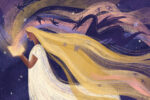When I was in middle school, the first “Percy Jackson” film came out amidst significant fanfare. Everyone was excited to see those thrilling books about kids grappling with magical powers displayed on screen in all its splendor. These film adaptations were supposed to be big, capturing the public imagination; they were supposed to be the next “Harry Potter.” Spoiler alert! They weren’t. In fact, these movies did little else but give rise to a generation of young nerds that were devoted to Riordan’s literary universe — kids who went around touting the eternal slogan found on coffee mugs and T-shirts from Etsy: The book was better.
In theory, nothing should give you greater pleasure than sitting in front of a big screen, popcorn in hand, to watch the film adaptations of some of your favorite stories. But nothing is worse than seeing it done disastrously wrong, like the director decided to create the movie just a few degrees too far to the left — the casting isn’t quite right, the costume design is anachronistic, they skipped a few scenes here and there that were key to the storyline. Fans of the book are everything from ecstatic to grumbly to foaming at the mouth when they see how their favorite literature was butchered by Hollywood.
I was definitely closer to the latter when I saw how “Percy Jackson” was treated. And people had equally strong reactions when they saw the “Lord of the Rings” movies or the Bourne franchise, or any number of other books that were adapted for the big screen. While some of these movies did their job, most people found more than enough problems with the adaptations. But why exactly do book-to-movie or book-to-TV-show adaptations always somehow miss the mark? When directors take stories that were originally designed for the page and throw them up on screen, what are they forgetting that causes riots to erupt within fandoms?
The chief critique that fans of books have of their movie counterparts revolves around the accuracy of the adaptation — the success of a movie or TV show adaptation stems from how true it stays to its source material. And sometimes, this is quite literal: “Percy Jackson” fans were angry when the movie version of Annabeth’s hair was brown since in the books, her blonde hair is one of her defining features. A seemingly small choice like this on the part of the director has repercussions for the audience’s trust in the film and therefore impacts its commercial success, which were serious enough that in the second “Percy Jackson” film, the actress’ hair was dyed blonde.
But when fans say that a film adaptation of a book is inaccurate, they aren’t just talking about how the actors look or the plot points the story hits. They also mean that the on-screen version doesn’t do their beloved characters justice. The emotional arcs and physical journeys that a book generously explores for each of its characters are typically not represented on TV. On top of that, people experience the same book in radically different ways; the readers’ own life experiences inform their individualized conceptions of characters.
The medium of literature offers a significant amount of leeway for creators: Because it as a medium is uncomplicated and accessible, the actual story can afford to be as long and complicated as the creator wants. But film, according to the Atlantic, is so heavily intertwined with marketability and commercial viability that it becomes difficult to engage with and portray the complexity of the book. The world of film is hampered by many things that don’t affect literature in quite the same way: a tight budget, time constraints and mainstream standards of success (which includes toeing the line between realist and offensive).
To put it another way, literature comes with the privilege of experimentation. Writers can creatively and extensively draw out the trials and tribulations of their characters however they see fit. This isn’t to say that writing novels liberates you from the concern of commercial success, but a successful novel is determined by very different metrics than a successful movie.
As an article from Slate says, “Novels are long, but movies are short. It’s impossible to encapsulate the tonal shifts of a book … in a feature-length film.” The demands of the film medium typically don’t leave much room for exploring complex human interiority the way the space on the page does, so “the movie replaces character with plot, and the result lands with a wet flop.”
Arguably one of the best and most successful modern film adaptations is the “Harry Potter” franchise, which warrants no introduction — its cult following hasn’t diminished over the years and it is still inspiring people across the world. These films succeeded where many film adaptations did not — its age-accurate casting and set design were two of its major strengths, not to mention the fact that throughout the franchise, it took many lines directly from the books themselves.
In this way, it never lost sight of the text it was trying to bring to life. Now, the actors are forever associated with their Potter counterparts, for better or for worse, and they have indelibly rewritten the way fans conceptualize the characters. In fact, it might be true that the Potter films were indeed better than their source material — especially in the latter half of the main franchise, the films committed to the darkness in the books that Rowling did not often make explicit, on account of them being children’s novels.
Films are a team effort in exactly the way novels written by typically just one person are not — the Potter films were such monumental successes not just because they drew on books that were also monumental successes, but because the directors worked hand-in-hand with the actors, sound designers, art directors and editors, who all brought different perspectives to the creation of a single product. That collaboration made it so “that the movie actually [fixed] problems from the book” — a rarity.
But what happens when one film adaptation tries to fix another? In 2013, author Cassandra Clare’s “The Mortal Instruments: City of Bones” was turned into a film and received a whopping 14% approval rating on Rotten Tomatoes. Suffice to say, the film was a sore disappointment after a book that was packed with humor, effective world-building and (YA’s favorite trope) lots of good-looking teenagers with magical powers. For three years, everyone thought that was the end of “The Mortal Instruments” on screen, but then Freeform swooped up the franchise to create a TV show based on the book and called it “Shadowhunters.” A new cast, a new set and fresh eyes. Fans were ecstatic.
It isn’t often — or ever, really — that beloved books get an on-screen do-over. The executive producer of “Shadowhunters,” Ed Decter, said that Clare’s books are so packed that any movie would flounder trying to show everything off at once. “One of the great parts about the books,” he said in an interview, “is that they really should have been a television show from the beginning.” The TV show slowed down the narrative significantly, taking it the way the books wrote it and using the valuable time it had to represent each character’s backstory and interiority accurately. Alas, all good things must come to an end — this show, too, was cancelled after three seasons due to financial reasons.
The tussle between film adaptations and their literary sources ultimately comes down to the limitations in both art forms. While books might have the luxury of flexibility, they ask for effort and commitment from their readers in a way that film does not. On-screen, and with good actors, the audience has the pleasure of seeing small quirks — a tiny smirk in between lines of dialogue, a stare held just slightly too long, overlapping yells and cries during an emotional fight — that run the risk of sounding stilted and unnatural when written down. Books let their readers create alongside their writers; films let their viewers experience alongside their directors.
Both mediums work best when they’re complementing one another. The film adaptation is at its strongest when it borrows in earnest from its book, which has its own ways of paying homage to the films. In 2005 when “Harry Potter and the Half Blood Prince” was released in print form, the movies had already been in production for four years. And there’s a little moment buried in the pages of the sixth book where the two counterparts come together nicely: old Professor Slughorn mistakenly addresses Ron Weasley as “Rupert,” which is, of course, the name of the actor who played Ron. In this lightning-fast moment, the film and the book come together — and that’s magic right there.
















